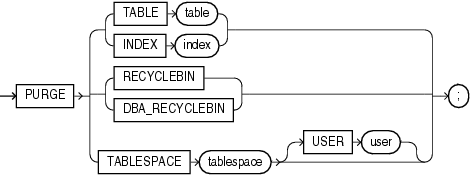| Oracle® Database SQL Reference 10g Release 2 (10.2) Part Number B14200-02 |
|
|
View PDF |
| Oracle® Database SQL Reference 10g Release 2 (10.2) Part Number B14200-02 |
|
|
View PDF |
Purpose
Use the PURGE statement to remove a table or index from your recycle bin and release all of the space associated with the object, or to remove the entire recycle bin, or to remove part of all of a dropped tablespace from the recycle bin.
|
Caution: You cannot roll back aPURGE statement, nor can you recover an object after it is purged. |
To see the contents of your recycle bin, query the USER_RECYCLEBIN data dictionary review. You can use the RECYCLEBIN synonym instead. The following two statements return the same rows:
SELECT * FROM RECYCLEBIN; SELECT * FROM USER_RECYCLEBIN;
|
See Also:
|
Prerequisites
The database object must reside in your own schema or you must have the DROP ANY... system privilege for the type of object to be purged, or you must have the SYSDBA system privilege.
Syntax
purge::=

Semantics
TABLE or INDEX
Specify the name of the table or index in the recycle bin that you want to purge. You can specify either the original user-specified name or the system-generated name Oracle Database assigned to the object when it was dropped.
If you specify the user-specified name, and if the recycle bin contains more than one object of that name, then the database purges the object that has been in the recycle bin the longest.
System-generated recycle bin object names are unique. Therefore, if you specify the system-generated name, then the database purges that specified object.
When the database purges a table, all table partitions, LOBs and LOB partitions, indexes, and other dependent objects of that table are also purged.
RECYCLEBIN
Use this clause to purge the current user's recycle bin. Oracle Database will remove all objects from the user's recycle bin and release all space associated with objects in the recycle bin.
DBA_RECYCLEBIN
This clause is valid only if you have SYSDBA system privilege. It lets you remove all objects from the system-wide recycle bin, and is equivalent to purging the recycle bin of every user. This operation is useful, for example, before backward migration.
TABLESPACE tablespace
Use this clause to purge all the objects residing in the specified tablespace from the recycle bin.
USER user Use this clause to reclaim space in a tablespace for a specified user. This operation is useful when a particular user is running low on disk quota for the specified tablespace.
Examples
Remove a File From Your Recycle Bin: Example The following statement removes the table test from the recycle bin. If more than one version of test resides in the recycle bin, Oracle Database removes the version that has been there the longest:
PURGE TABLE test;
To determine system-generated name of the table you want removed from your recycle bin, issue a SELECT statement on your recycle bin. Using that object name, you can remove the table by issuing a statement similar to the following statement. (The system-generated name will differ from the one shown in the example.)
PURGE TABLE RB$$33750$TABLE$0;
Remove the Contents of Your Recycle Bin: Example To remove the entire contents of your recycle bin, issue the following statement:
PURGE RECYCLEBIN;